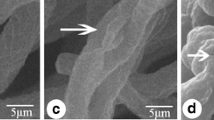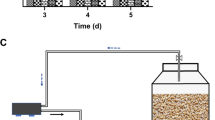Abstract
Octanal is a potential alternative to chemical fungicides in controlling postharvest disease of citrus fruit. In this study, the antifungal activity and the underlying mechanism of octanal against spore germination of Penicillium digitatum, one of the main postharvest pathogens in citrus, were investigated. Results showed that octanal at different concentrations (0, 0.25, 0.50, 1.00, 2.00 μl/ml) inhibited the growth of P. digitatum spores in a dose-dependent manner. The morphology and the membrane permeability of P. digitatum spores were visibly altered by 0.25 and 2.00 μl/ml of octanal. Meanwhile, octanal decreased the total lipids contents of P. digitatum spores, indicating that the membrane integrity is damaged. Furthermore, octanal apparently induced the massive accumulation of total malonaldehyde (MDA) and the reactive oxygen species (ROS). An increase in the activities of lipoxygenase (LOX), NADH oxidase, superoxide dismutase (SOD), catalase (CAT), and peroxidase (POD) was also observed. These results suggested that a membrane damage mechanism involving membrane peroxidation might contribute to the antifungal activity of octanal against P. digitatum spores.









Similar content being viewed by others
References
Bakkali F, Averbeck S, Averbeck D et al (2008) Biological effects of essential oils–a review. Food Chem Toxicol 46(2):446–475
Ballester AR, Lafuente MT, González-Candelas L (2006) Spatial study of antioxidant enzymes, peroxidase and phenylalanine ammonia-lyase in the citrus fruit–Penicillium digitatum interaction. Postharvest Biol Technol 39(2):115–124
Bard M, Albrecht MR, Gupta N et al (1998) Geraniol interferes with membrane functions in strains of Candida and Saccharomyces. Lipids 23(6):534–538
Chowhan N, Singh HP, Batish DR et al (2013) β-pinene inhibited germination and early growth involves membrane peroxidation. Protoplasma 250(3):691–700
Fan F, Tao NG, Jia L et al (2014) Use of citral incorporated in postharvest wax of citrus fruit as a botanical fungicide against Penicillium digitatum. Postharvest Biol Technol 90:52–55
Gao M, Ng TW, An T et al (2016) The role of catalase and H2 O2 in photocatalytic inactivation of Escherichia coli: genetic and biochemical approaches. Catal Today 266:205–211
Halliwell B, Gutteridge JMC (2015) Free radicals in biology and medicine. Oxford University Press, USA
Harrewijn P, Van Oosten AM, Piron PGM (2012) Natural Terpenoids as messengers. A multicisciplinary study of their production, biological functions and practical applications. Springer Science & Business Media, Germany
Jaikua W, Kueakhai P, Chaithirayanon K et al (2016) Cytosolic superoxide dismutase can provide protection against Fasciola gigantica. Acta Trop 162:75–82
Jing L, Lei Z, Li L et al (2014) Antifungal activity of citrus essential oils. J Agric Food Chem 62(14):3011–3033
Maalekuu K, Elkind Y, Leikin-Frenkel A et al (2006) The relationship between water loss, lipid content, membrane integrity and LOX activity in ripe pepper fruit after storage. Postharvest Biol Technol 42(3):248–255
Macarisin D, Cohen L, Eick A et al (2007) Penicillium digitatum suppresses production of hydrogen peroxide in host tissue during infection of citrus fruit. Phytopathology 97(11):1491–1500
Nigam S, Schewe T (2000) Phospholipase A2s and lipid peroxidation. Biochimica et Biophysica Acta (BBA)-molecular and cell biology of. Lipids 1488:167–181
Paul S, Dubey RC, Maheswari DK et al (2011) Trachyspermum ammi (L.) fruit essential oil influencing on membrane permeability and surface characteristics in inhibiting food-borne pathogens. Food Control 22(5):725–731
Reverter-Branchat G, Cabiscol E, Tamarit J et al (2004) Oxidative damage to specific proteins in replicative and chronological-aged Saccharomyces cerevisiae common targets and prevention by calorie restriction. J Biol Chem 279(30):31983–31989
Riebel BR, Gibbs PR, Wellborn WB et al (2002) Cofactor regeneration of NAD+ from NADH: novel water-forming NADH oxidases. Adv Synth Catal 344(10):1156–1168
Scora KM, Scora RW (1998) Effect of volatiles on mycelium growth of Penicillium digitatum, P. italicum, and P. ulaiense. J Basic Microbiol 38(5–6):405–413
Sharma P, Jha AB, Dubey RS, et al. (2012) Reactive oxygen species, oxidative damage, and antioxidative defense mechanism in plants under stressful conditions. J Botany 2012
Sikkema J, De Bont JA, Poolman B (1995) Mechanisms of membrane toxicity of hydrocarbons. Microbiol Rev 59(2):201–222
Singh HP, Batish DR, Kaur S et al (2006) α-pinene inhibits growth and induces oxidative stress in roots. Ann Bot 98(6):1261–1269
Tao NG, Jia L, Zhou HE (2014a) Anti-fungal activity of Citrus reticulata Blanco essential oil against Penicillium italicum and Penicillium digitatum. Food Chem 153:265–271
Tao NG, OuYang QL, Jia L (2014b) Citral inhibits mycelial growth of Penicillium italicum by a membrane damage mechanism. Food Control 41:116–121
Tao NG, Fan F, Jia L et al (2014c) Octanal incorporated in postharvest wax of Satsuma mandarin fruit as a botanical fungicide against Penicillium digitatum. Food Control 45:56–61
Tian J, Wang Y, Zeng H et al (2015) Efficacy and possible mechanisms of perillaldehyde in control of Aspergillus niger causing grape decay. Int J Food Microbiol 202:27–34
Tyagi AK, Malik A (2010) Liquid and vapour-phase antifungal activities of selected essential oils against Candida albicans: microscopic observations and chemical characterization of Cymbopogon citratus. BMC Complement Altern Med 10(1):1
Wolken WAM, Tramper J, van der Werf MJ (2002) Toxicity of terpenes to spores and mycelium of Penicillium digitatum. Biotechnol Bioeng 80(6):685–690
Wuryatmo E, Klieber A, Scott ES (2003) Inhibition of citrus postharvest pathogens by vapor of citral and related compounds in culture. J Agric Food Chem 51(9):2637–2640
Zhang Z, Qin G, Li B et al (2015) Effect of Cinnamic acid for controlling gray mold on table grape and its possible mechanisms of action. Curr Microbiol 71(3):396–402
Zheng SJ, Jing GX, Wang X et al (2015) Citral exerts its antifungal activity against Penicillium digitatum by affecting the mitochondrial morphology and function. Food Chem 178:76–81
Zhou HE, Tao NG, Jia L (2014) Antifungal activity of citral, octanal and α-terpineol against Geotrichum citri-aurantii. Food Control 37:277–283
Acknowledgements
This study was supported by Collaborative Innovation Center of New Chemical Technologies for Environmental Benignity and Efficient Resource Utilization, the National Natural Science Foundation of China (No. 31271964), Research Foundation of Education Bureau of Hunan Province (No. 15A181), and the Natural Science Foundation of Jiangsu Province (Grants No. BK20131228).
Author information
Authors and Affiliations
Corresponding author
Ethics declarations
Conflict of interest
We declared that no conflict of interest existed.
Additional information
Handling Editor: Peter Nick
Rights and permissions
About this article
Cite this article
Dou, S., Liu, S., Xu, X. et al. Octanal inhibits spore germination of Penicillium digitatum involving membrane peroxidation. Protoplasma 254, 1539–1545 (2017). https://doi.org/10.1007/s00709-016-1046-z
Received:
Accepted:
Published:
Issue Date:
DOI: https://doi.org/10.1007/s00709-016-1046-z




